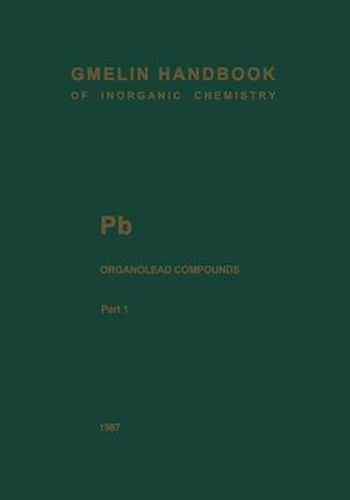Readings Newsletter
Become a Readings Member to make your shopping experience even easier.
Sign in or sign up for free!
You’re not far away from qualifying for FREE standard shipping within Australia
You’ve qualified for FREE standard shipping within Australia
The cart is loading…






This title is printed to order. This book may have been self-published. If so, we cannot guarantee the quality of the content. In the main most books will have gone through the editing process however some may not. We therefore suggest that you be aware of this before ordering this book. If in doubt check either the author or publisher’s details as we are unable to accept any returns unless they are faulty. Please contact us if you have any questions.
FoLLowing the first synthesis of an organoLead compound by Loewig in 1852, progress sLowed markedLy in organoLead chemistry. Then, the discovery of the outstanding performance of organoLead compounds as antiknock additives to automobiLe gasoline turned organoLead chemistry into one of the main areas of organometallic chemistry. Large-scaLe industriaL procedures for synthesizing tetraethyLLead and other tetraaLkyLLead compounds and entireLy new techniques, such as handling Large amounts of sodium-Lead aLLoys or eLectroLyzing Grignard soLutions, were deveLoped, and many other industriaL projects as weLL as toxicoLogicaL and environmentaL studies brought a tremendous increase of knowLedge. Therefore, a compiLation of the avaiLabLe data in organoLead chemistry seemed justified. In the present series onLy compounds containing at Least one Lead-to-carbon bond are considered; the simpLe inorganic cyanides, carbides, etc. , are excLuded. The materiaL is organized as foLLows: 1. MononucLear compounds (compounds containing onLy one Lead atom) 2. DinucLear compounds 3. OLigo-and poLynucLear compounds Within the group of mononucLear compounds the materiaL is arranged in a simiLar way as in the GmeLin voLumes of the sister eLement tin, that is: 1. 1 * Compounds containing four Pb-C bonds 1. 2 Compounds containing Pb-H bonds 1. 3 Compounds containing bonds between Lead and group 17 eLements 1. 4 Compounds containing bonds between Lead and group 16 eLements 1. 5 Compounds containing bonds between Lead and group 15 eLements 1. 6 Compounds containing bonds between Lead and Si, Ge, or Sn 1.
$9.00 standard shipping within Australia
FREE standard shipping within Australia for orders over $100.00
Express & International shipping calculated at checkout
This title is printed to order. This book may have been self-published. If so, we cannot guarantee the quality of the content. In the main most books will have gone through the editing process however some may not. We therefore suggest that you be aware of this before ordering this book. If in doubt check either the author or publisher’s details as we are unable to accept any returns unless they are faulty. Please contact us if you have any questions.
FoLLowing the first synthesis of an organoLead compound by Loewig in 1852, progress sLowed markedLy in organoLead chemistry. Then, the discovery of the outstanding performance of organoLead compounds as antiknock additives to automobiLe gasoline turned organoLead chemistry into one of the main areas of organometallic chemistry. Large-scaLe industriaL procedures for synthesizing tetraethyLLead and other tetraaLkyLLead compounds and entireLy new techniques, such as handling Large amounts of sodium-Lead aLLoys or eLectroLyzing Grignard soLutions, were deveLoped, and many other industriaL projects as weLL as toxicoLogicaL and environmentaL studies brought a tremendous increase of knowLedge. Therefore, a compiLation of the avaiLabLe data in organoLead chemistry seemed justified. In the present series onLy compounds containing at Least one Lead-to-carbon bond are considered; the simpLe inorganic cyanides, carbides, etc. , are excLuded. The materiaL is organized as foLLows: 1. MononucLear compounds (compounds containing onLy one Lead atom) 2. DinucLear compounds 3. OLigo-and poLynucLear compounds Within the group of mononucLear compounds the materiaL is arranged in a simiLar way as in the GmeLin voLumes of the sister eLement tin, that is: 1. 1 * Compounds containing four Pb-C bonds 1. 2 Compounds containing Pb-H bonds 1. 3 Compounds containing bonds between Lead and group 17 eLements 1. 4 Compounds containing bonds between Lead and group 16 eLements 1. 5 Compounds containing bonds between Lead and group 15 eLements 1. 6 Compounds containing bonds between Lead and Si, Ge, or Sn 1.